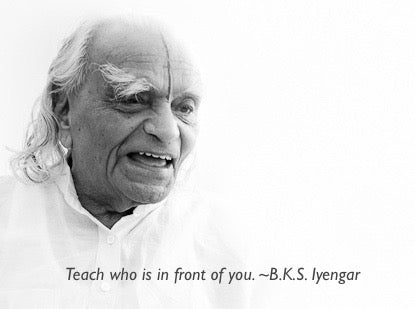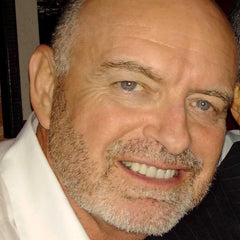
Many times at the end of my Iyengar yoga class I thank my yoga teacher for saving my life. Most of them, including my most cherished, long time Iyengar Teacher, Scott Hobbs, simply smile and acknowledge. As someone with a high stress job that involves lots of heavy lifting, my Iyengar practice has many a time healed my back and saved my sanity. I’ve asked Scott to weigh-in on some key benefits about Why You Too Should Try an Iyengar Class.
About. Grounded in a deeply mind-body-soul spiritual belief system, Iyengar Yoga was created by yoga master B.K.S. Iyengar who began teaching in Pune, India in 1936 at the age of 18 until his death at age 95. Today, his daughter, Geeta, and his son, Prashant—both accomplished teachers themselves—continue his teachings at the Iyengar Institute in India. Therefore, according to Scott, unlike many other yoga practices, Iyengar is a living, constantly evolving, progressive yoga method.The Iyengar family’s teachings are deeply grounded in the yoga sutras of Patanjali, an ancient summation of the path and philosophy of yoga considered to be at least 2,500 years old. B.K.S. Iyengar’s intense practice and over seventy years of teaching have produced significant innovations in the teaching of the art and science of yoga.
The Iyengar method develops self-awareness, intelligent evaluation, and profound inward reflection. The attention to detail and cultivation of awareness is meant to maintain physical safety in the practice, AND also to develop the mental benefits of a complete meditation in action.
B.K.S. focused his yoga methodology to help and actually cure multiple ailments and disorders. These include high blood pressure, depression, chronic neck and back pain, immunodeficiency and glandular imbalances—especially thyroid—to name a few. Here are a four additional powerful reasons/benefits to for you to consider trying an Iyengar yoga class:
Focus on correct anatomical alignment: Emphasis on precise anatomical alignment in all poses makes each pose healthy for joints, ligaments and muscles, allowing the body to develop harmoniously.
Accessibility through the use of props: Iyengar yoga uses props to help the student, regardless of their capabilities or limitations, reach the desired pose (asana). Blankets, belts, chairs, ropes, wooden blocks, and more are used in Iyengar yoga to reach a deeper penetration into the postures. This is key to strengthening the natural curvatures of the spine according to Scott.
Instructors complete comprehensive and rigorous certification: As a result of years of study, instructors can quickly recognize the individual needs of students and identify which props to use and how. Everyone is an individual in life and in yoga. Instructors are taught to understand this key component to help guide students to reach rewarding, profound poses. Iyengar respects boundaries per Scott. “Teach who is in front of you.” ~B.K.S. Iyengar
Longer holds of poses: Higher levels of strength, flexibility, healing and awareness can be reached when more time is spent in each asana (pose). During this time, students reach new levels of consciousness while practicing yoga.
Iyengar is movement appropriate for every level and age versus high impact aerobics, running, etc., according to Scott. I personally love taking an Iyengar class with people who range from Millennials to mid-eighty year olds. It’s a pretty powerful and awe inspiring statement about community and acceptance—something we could all use a little more of these days…

Scott Hobbs has been practicing and teaching Iyengar yoga for over 35 years. He is a graduate of the first Iyengar teacher training held in Los Angeles in 1981. He started the Iyengar Yoga Institute of Los Angeles in 1984 and was one of the first group of Americans to be certified as an Iyengar Yoga teacher that same year. He is fortunate to have studied yoga with B.K.S. Iyengar and his children Geeta and Prashant.
Currently he teaches at YogaWorks throughout the Los Angeles area. Scott’s classes not only feature his many years of expertise but a healthy dose of humor as well. He is a long time vegetarian and vegan, actively involved in the animal rights movement.Scott is also the Director of the Cameron Parsons Foundation established in 2006 for the purpose of bringing attention to and conserving the artwork and the writings of the late artist Cameron and her first husband, the late scientist and writer Jack Parsons.
